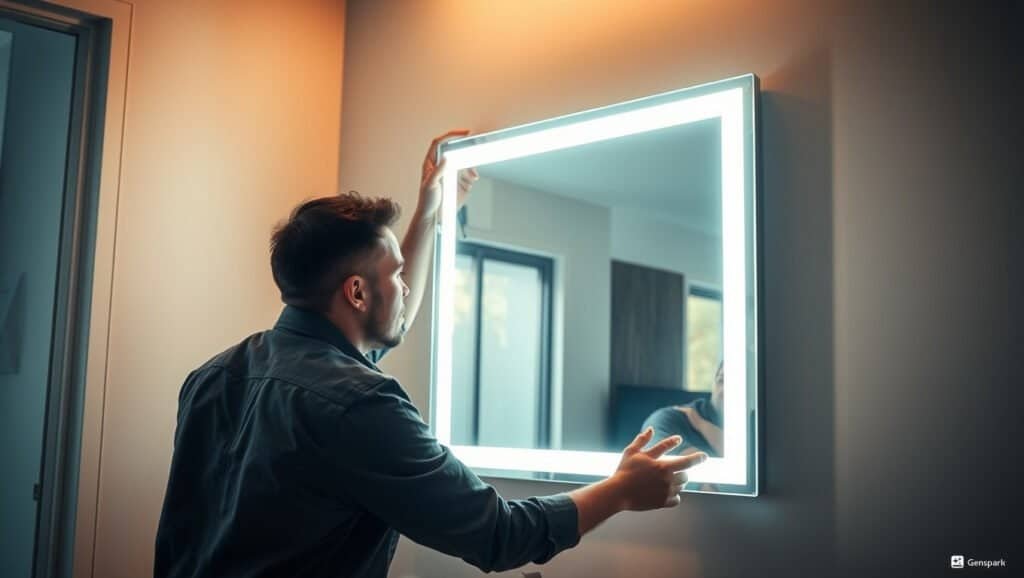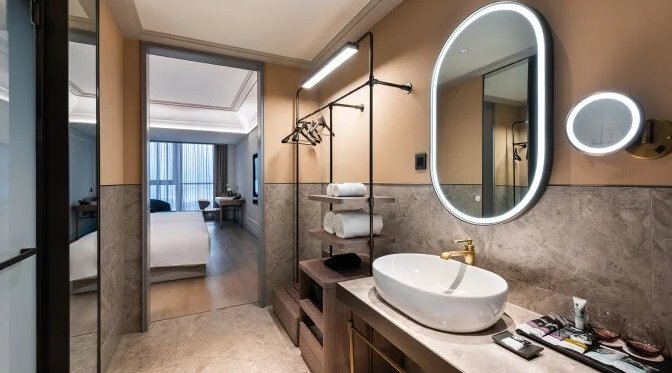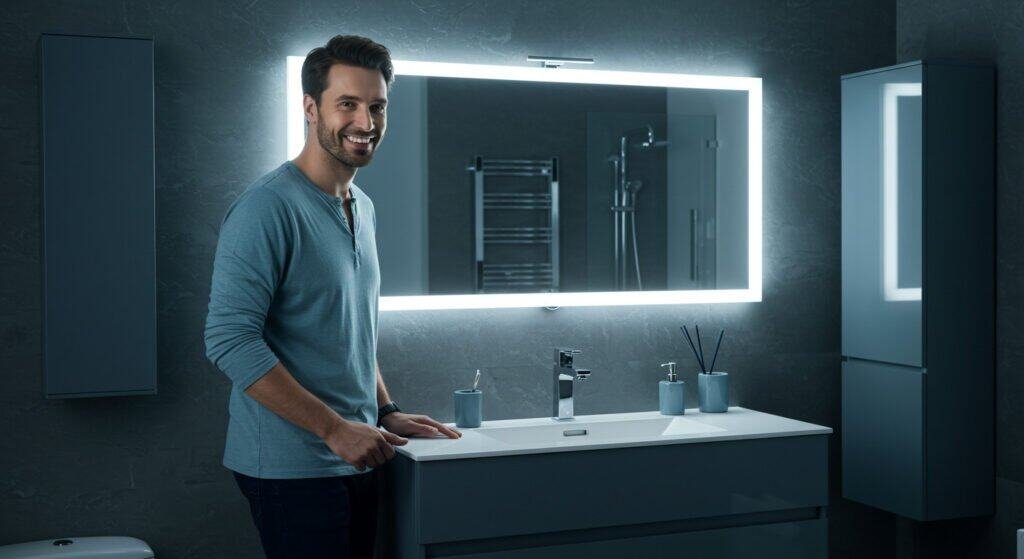Touch Sensor Mirror Not Working is the problem we will have when we use the smart mirror.
1. Check the Power Supply
- Verify the Connection: Ensure that the mirror is properly plugged into an active outlet.
- Stability of the Power Supply: Confirm that the power supply is stable. If you suspect an issue, try plugging the mirror into a different socket or, if applicable, check the battery charge.
2. Inspect the Wiring
- Examine Internal Connections: Check for any loose or damaged wiring inside the mirror.
- Professional Assistance: If you suspect wiring issues, consider contacting a professional technician to inspect and repair the connections.
3. Evaluate the Sensor
- Sensor Functionality: If your touch sensor mirror is new and not working, the sensor itself might be faulty.
- Manufacturer Support: Contact the manufacturer or your supplier for a potential replacement if you suspect sensor failure.

4. Reduce Electrical Interference
- Identify Interference Sources: Ensure that no nearby electronic devices are interfering with the sensor’s operation.
- Adjust the Setup: Try relocating the mirror or the interfering devices to minimize electrical disturbances.
5. Clean the Sensor Surface
- Remove Contaminants: Dust, stains, or moisture on the sensor surface can affect its performance.
- Cleaning Process: Gently wipe the sensor surface with a clean, soft cloth to remove any dust, stains, or moisture, ensuring it is dry.
6. Reset the Mirror
- Simple Reset: If the issue persists after cleaning and checking connections, reset the mirror.
- Power Cycle: Turn off the mirror, wait for a few minutes, and then turn it back on. If available, use the reset button as instructed by the manufacturer.
7. Seek Professional Help
- Persistent Issues: If none of the above steps resolve the issue, consider replacing the sensor or contacting professional technical support for further diagnosis and repair.
Common Reasons Your Touch Sensor Mirror Isn’t Working
Touch sensor technology in LED mirrors has revolutionized bathroom experiences, but like any electronic device, they can encounter operational challenges. Understanding the root causes is the first step to resolution.
The primary culprits behind touch sensor mirror malfunctions include electrical connectivity issues, sensor sensitivity problems, environmental interference, and potential hardware degradation. By systematically examining these factors, you can often diagnose and resolve the issue without professional intervention.
A comprehensive analysis reveals that most touch sensor mirror problems stem from power supply interruptions, sensor calibration errors, or physical damage. Recognizing these potential issues empowers users to take proactive maintenance steps.

Why is the sensor on my bathroom mirror not working?
Electronic sensors are delicate components requiring specific conditions to function optimally. Power inconsistencies, moisture exposure, and accumulated debris can significantly impair their performance.
Touch sensors in bathroom mirrors operate through precise electrical conductivity. When dust, soap residue, or water droplets accumulate, they can create a barrier that prevents accurate touch detection. Regular cleaning and proper maintenance are crucial for sustained sensor functionality.
Detailed investigations suggest that environmental factors play a substantial role in sensor performance. Humidity levels, temperature fluctuations, and direct water exposure can compromise the intricate electronic mechanisms within your LED mirror’s touch sensor system.
Why is my lighted mirror not working?
Lighted mirrors represent a sophisticated integration of illumination and touch-based technology. When they malfunction, multiple systems might be involved, from LED circuitry to touch control mechanisms.
LED mirror issues often relate to power supply disruptions, faulty wiring, or degraded LED strips. A systematic approach involves checking electrical connections, examining the power adapter, and verifying the integrity of internal wiring and LED components.
Professional diagnostics recommend a step-by-step verification process: confirm power supply stability, inspect visible wiring connections, test the power adapter’s output, and assess the LED strip’s functionality through careful visual and electrical examinations.
Why is my Bluetooth mirror not working?
Bluetooth-enabled mirrors introduce additional technological complexity to standard touch sensor systems. Connectivity issues can arise from software, hardware, or environmental interference.
Bluetooth functionality depends on precise signal transmission and device pairing. Factors like wireless interference, outdated firmware, or incompatible device settings can disrupt the seamless connection between your mirror and external devices.
Advanced troubleshooting involves resetting Bluetooth connections, updating firmware, checking device compatibility, and ensuring no significant electromagnetic interference exists in your immediate environment.

How to Maintain Your Touch Sensor Mirror for Longevity?
Preventative maintenance is key to extending your touch sensor mirror’s operational lifespan. Regular, careful cleaning and mindful usage can significantly reduce the likelihood of technical failures.
Implement a consistent maintenance routine that includes gentle cleaning with appropriate microfiber cloths, avoiding abrasive materials, and keeping the sensor area free from moisture and debris. Periodic electrical connection checks can preempt potential issues.
Comprehensive maintenance involves understanding your mirror’s specific technological specifications, following manufacturer guidelines, and creating an environment that minimizes potential electronic stress and degradation.
Why Quality Control Matters When Sourcing Touch Sensor Mirrors?
Not all touch sensor mirrors are created equal. Quality control during manufacturing plays a crucial role in determining product reliability and long-term performance.
Investing in mirrors from reputable manufacturers with stringent quality control processes ensures better sensor technology, more reliable touch responsiveness, and reduced likelihood of premature technical failures.
Detailed quality assessments should examine sensor sensitivity, electrical stability, water resistance ratings, and overall manufacturing precision to guarantee a superior, long-lasting product.
How to Fix the Touch Sensor on Your Mirror?
DIY repairs require careful approach and basic understanding of electronic systems. Some issues can be resolved without professional intervention.
Begin by isolating the specific problem: is it a power issue, sensor malfunction, or connection problem? Systematic diagnostic steps can help identify and potentially rectify minor technical complications.
Professional technicians recommend a methodical troubleshooting process involving visual inspection, electrical testing, and careful component examination before attempting any repairs.

how to reset simplehuman mirror?
Simplehuman mirrors often require specific reset procedures to restore functionality. Understanding the manufacturer’s recommended reset protocol is essential.
Typical reset methods involve disconnecting the power source, waiting for a specified duration, and then reconnecting. Some models might require pressing specific button combinations or following unique manufacturer guidelines.
Careful adherence to the specific Simplehuman mirror model’s reset instructions can often resolve temporary operational glitches and restore full functionality.
How Do You Clean a Touch Sensor?
Proper cleaning is critical for maintaining touch sensor responsiveness. Improper cleaning can cause more harm than good.
Use soft, lint-free microfiber cloths slightly dampened with water or specialized electronic cleaning solutions. Avoid excessive moisture and abrasive materials that could damage sensitive electronic components.
Gentle, systematic cleaning techniques involve minimal liquid application, careful wiping motions, and thorough drying to prevent potential electrical interference or damage.
How Long Do Lighted Mirrors Last?
The lifespan of lighted mirrors varies based on manufacturing quality, usage patterns, and maintenance practices.
High-quality LED mirrors typically last between 7-10 years with proper care. Factors influencing longevity include LED strip quality, touch sensor durability, and consistent maintenance practices.
Investing in premium mirrors, implementing regular maintenance, and avoiding extreme environmental conditions can significantly extend your mirror’s operational lifespan.

Conclusion
Touch sensor mirror issues need not be a source of perpetual frustration. With systematic troubleshooting, regular maintenance, and informed decision-making, you can ensure a reliable, high-performance mirror experience.


